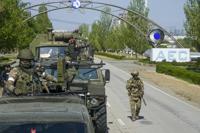Russia has devised yet another way to spread disinformation about its invasion of Ukraine, using digital tricks that allow its war propaganda videos to evade restrictions imposed by governments and tech companies.
Accounts linked to Russian state-controlled media have used the new method to spread dozens of videos in 18 , all without leaving telltale signs that would give away the source, researchers at Nisos, a U.S.-based intelligence and other cyber threats, said in a .
The videos push Kremlin conspiracy theories blaming Ukraine for civilian casualties as well as claims that residents of have welcomed their occupiers.
English-language versions of the Russian propaganda videos are now circulating on Twitter and lesser-known platforms popular with American conservatives, including Gab and Truth Social, created by former President Donald Trump,
In an indication of the Kremlin's ambitions and the of its , versions of the videos were also created in Spanish, Italian, German and more than a dozen other languages.
“The genius of this approach is that the videos can be downloaded directly from Telegram and it erases the trail that researchers try to follow," Nisos' senior intelligence analyst Patricia Bailey told The Associated Press. “They are creative and adaptable. And they are analyzing their audience.”
The European Union moved to , two of Russia's leading state-run media outlets, after Russia's invasion of Ukraine in late February. Tech companies such as Google's YouTube and Meta's Facebook and Instagram also announced they would within the 27-nation EU, undermining Russia's ability to spread its propaganda.
Russian attempts to get around the new rules began almost immediately. New websites were created to host videos that make debunked claims about the war.
The latest effort revealed by analysts at Nisos involved uploading propaganda videos to Telegram, a loosely moderated platform that is broadly popular in Eastern Europe and used by many conservatives in the United States. In some cases, watermarks identifying the video as RT's were removed in a further attempt to disguise their source.
Once on Telegram, the videos were downloaded and reposted on platforms including Twitter without any labels or other indications that the video was produced by Russian state media. Hundreds of accounts that later posted or reposted the videos were linked by Nisos researchers to the Russian military, embassies or state media.
Some of the accounts appeared to use fake profile photos or posted content in strange ways that suggested they were inauthentic.
One example: a Twitter account supposedly run by a woman living in Japan that had a singular interest in Russian propaganda. Instead of posting about a variety of topics such as entertainment, food, travel or family, the account user only posted Russian propaganda videos — and not just in Japanese, but also in Farsi, Polish, Spanish and Russian.
The account also cited or reposted content from Russian embassies hundreds of times, researchers found, showing again the close relationship between Russian diplomats and the country's propaganda work.
When it comes to Russia's overall disinformation capabilities, Bailey said, the network is “just one piece of a puzzle that is quite large."
Twitter labels content that it can identify as coming from Russian state media. Since late February, the company says it's added labels to more than 900,000 different Tweets that contained links to Russian state outlets like RT. In addition, the platform does not artificially promote content from state media accounts.
“We use labels to make it clear on Twitter when an account is operated by a state actor, such as a state-backed media outlet, and we will not recommend or amplify Tweets from these types of accounts,” a company spokesperson told The AP.
More examples of Russian disinformation campaigns have emerged as the war has dragged on.
Last week, Russia blaming the U.S. for sabotage to the Nord Stream natural gas pipelines in the Baltic Sea.
The same week, Meta announced the discovery of a that created websites designed to look like major European news outlets. Instead of news, the websites carried propaganda intended to drive a wedge between Ukraine and its western allies.
That operation was the largest of its kind to originate in Russia since the war began, researchers concluded.
“The network exhibited an overarching pattern of targeting Europe with anti-Ukraine narratives and expressions of support for Russian interests,” according to a report from the Atlantic Council's Digital Forensic Research Lab, which helped identify the network disabled by Meta.
___
Follow AP’s coverage of the war in Ukraine at








































